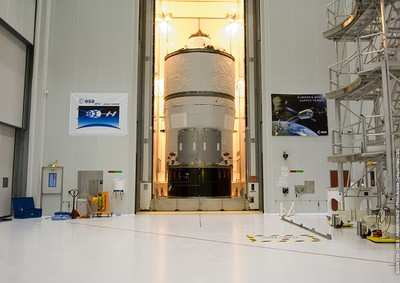Jules Verne Lifted Off Sunday, Will Dock In April
 Jules Verne -- the
first of the European Space Agency's Automated Transfer Vehicles
(ATV), a new series of autonomous spaceships designed to re-supply
and re-boost the International Space Station (ISS) -- was
successfully launched into low Earth orbit by an Ariane 5 vehicle
Sunday morning. During the coming weeks, it will manoeuvre in order
to rendezvous and eventually dock with the ISS to deliver cargo,
propellant, water and oxygen to the orbital outpost.
Jules Verne -- the
first of the European Space Agency's Automated Transfer Vehicles
(ATV), a new series of autonomous spaceships designed to re-supply
and re-boost the International Space Station (ISS) -- was
successfully launched into low Earth orbit by an Ariane 5 vehicle
Sunday morning. During the coming weeks, it will manoeuvre in order
to rendezvous and eventually dock with the ISS to deliver cargo,
propellant, water and oxygen to the orbital outpost.
Lift-off occurred at 05:03 CET (01:03 local) from the Guiana
Space Centre, Europe's spaceport in Kourou, French Guiana. This
flight required a new version of Europe's workhorse launcher, the
Ariane 5ES, specially adapted to the task of lofting the nearly
20-tonne vehicle -- more than twice as heavy as the previous
largest Ariane 5 payload -- to a low circular orbit inclined at
51.6 degrees relative to the Equator and equipped with an upper
stage with re-ignition capabilities.
The unusual launch trajectory required the deployment of two new
telemetry tracking stations, one on a ship in the Atlantic Ocean
and one on the Azores Islands. The Ariane 5 upper stage performed
an initial eight-minute burn over the Atlantic and entered a
45-minute coast phase, flying over Europe and Asia before
reigniting for a 40-second circularization burn over Australia.
Separation of Jules Verne ATV occurred at 06:09 CET (02:09 local)
and was monitored by a ground station located in New Zealand.
"Last month, with the docking of Columbus, Europe got its own
flat in the ISS building, with the launch of the first ATV, we now
have our own delivery truck" said Daniel Sacotte, ESA's Director
for Human Spaceflight, Microgravity and Exploration. "We have
become co-owners of the ISS, now we are about to become fully-
fledged partners in running it. With the ATV we will be servicing
the ISS by delivering cargo and providing orbital reboost."
Jules Verne ATV is now circling the Earth in the same orbital
plane as the ISS but at an altitude of only 260 km, compared to 345
km for the Station. After having demonstrated safety maneuvers in
free flight, the ATV will perform orbital 'phasing' maneuvers in
order to rendezvous with the ISS for a first docking slot scheduled
for April 3, after the departure of NASA's Space Shuttle
Endeavour.
 Named after the famous
French 19th century visionary and author, the Jules Verne ATV is
the largest and most sophisticated spacecraft ever developed in
Europe, combining the functions of an autonomous free-flying
platform, a maneuverable space vehicle and a space station
module.
Named after the famous
French 19th century visionary and author, the Jules Verne ATV is
the largest and most sophisticated spacecraft ever developed in
Europe, combining the functions of an autonomous free-flying
platform, a maneuverable space vehicle and a space station
module.
About 10 m high with a diameter of 4.5 m, it weighed 19,357 kg
at launch. It incorporates a pressurized module, derived from the
Columbus pressure shell, and a Russian-built docking system,
similar to those used on Soyuz manned ferries and on the Progress
re-supply ship.
About three times larger than its Russian counterpart, the ATV
can also deliver about three times more cargo. The ATV is also the
very first spacecraft in the world designed to conduct automated
docking in full compliance with the very tight safety constraints
imposed by human spaceflight operations.
On this first ATV mission, Jules Verne will deliver 4.6 tonnes
of payload to the ISS, including 1,150 kg of dry cargo, 856 kg of
propellant for the Russian Zvezda module, 270 kg of drinking water
and 21 kg of oxygen. On future ATV missions, the payload capacity
will be increased to 7.4 tonnes.

About half of the payload onboard Jules Verne ATV is re-boost
propellant, which will be used by its own propulsion system for
periodic maneuvers to increase the altitude of the ISS in order to
compensate its natural decay caused by atmospheric drag.
Upon leaving, after four months spent docked to the ISS, Jules
Verne ATV will carry away waste from the Station. It will then be
de-orbited over the Southern Pacific Ocean, and burn up in the
atmosphere.
Beyond Jules Verne, ESA has already contracted to produce four
more ATVs to be flown through to 2015.
 NTSB Final Report: Douglas A-4K
NTSB Final Report: Douglas A-4K ANN FAQ: Q&A 101
ANN FAQ: Q&A 101 Classic Aero-TV: PBY Catalina--From Wartime to Double Sunrise to the Long Sunset
Classic Aero-TV: PBY Catalina--From Wartime to Double Sunrise to the Long Sunset ANN's Daily Aero-Term (07.01.25): Advanced Air Mobility (AAM)
ANN's Daily Aero-Term (07.01.25): Advanced Air Mobility (AAM) ANN's Daily Aero-Linx (07.01.25)
ANN's Daily Aero-Linx (07.01.25)





